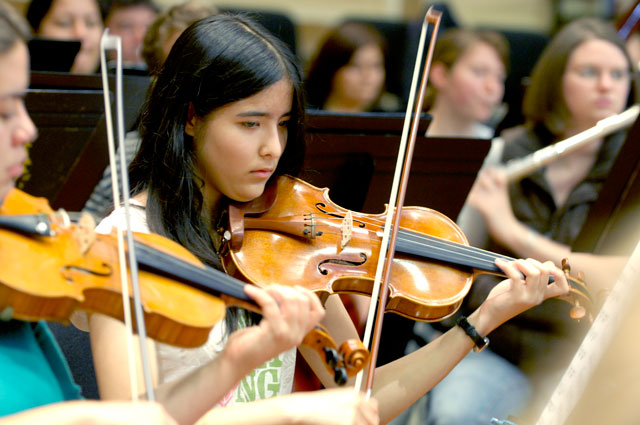
The evening’s centerpiece is Concertino da Camera by 20th century French composer Jacques Ibert, highlighting the American jazz and ragtime rhythms that took 1920s Paris by storm. Virginia Ryder is the featured soloist, in what Symphony conductor Paul Cummings calls “one of the greatest works for alto saxophone in the orchestra repertoire.”
Composer Ibert is known for his playfulness, and the Concertino takes the orchestra on a ride of fascinating rhythms, shifting harmonies and abrupt key changes. “It’s an enjoyable piece to play and to listen to,” Cummings said.
Other pieces on the program go deeper into music of the people, to traditional folk melodies. Percy Grainger’s contribution is self-explanatory: Irish Tune From County Derry. “This is one of Grainger’s primary works,” Cummings said. “This version is unique, though, because it includes strings. It’s a beautiful arrangement, based on the tune we know as Danny Boy.”
Anatol Liadov’s Eight Russian Folk Songs comprise his best known piece for orchestra. Member of the group of 19th century Russian composers known as The Mighty Handful, Liadov’s great talent was for orchestration. “He created a beautiful orchestral setting for these folk songs,” Cummings observed. “He chose really charming songs—very simple, lyrical tunes. But he orchestrates them with very challenging combinations of instruments—for example, the cello section plays a four-part harmony—very unusual. There’s also a lot of contrast from one melody to the next.” Humorous, somber, a lullaby, a dance and a bit of birdsong—a mighty handful indeed.
Intermezzo from Hary Janos Suite by 20th century Hungarian composer Zoltan Kodaly is from the instrumental music of an opera about a Hungarian folk hero, a “crazy uncle” who tells outlandish lies that express the hopes and dreams of the Hungarian people. “This is a colorful piece, also with inventive orchestration.”
The non-populist sore thumb of the program is British composer William Walton’s Crown Imperial March, played at the coronation of King George VI in 1937, and substantially revised in 1963. But if Walton didn’t borrow from the people for this acclaimed piece, he at least reputedly borrowed from a friend—Edward Elgar. Listeners detected some echoes of one of Elgar’s Pomp and Circumstance marches. “This is one of Walton’s best known pieces,” Cummings said. “It’s usually played by bands, but it actually sounds better played by the orchestra.”
The Humboldt Symphony under the direction of Paul Cummings and featuring saxophone soloist Virginia Ryder, performs on Saturday, March 6 at 8 p.m. in the Fulkerson Recital Hall on the HSU campus in Arcata. Tickets are $7 general, $3 students/seniors, from the HSU Ticket Office (826-3928) or at the door. Free to HSU students with ID. http://HSUMusic.blogspot.com.